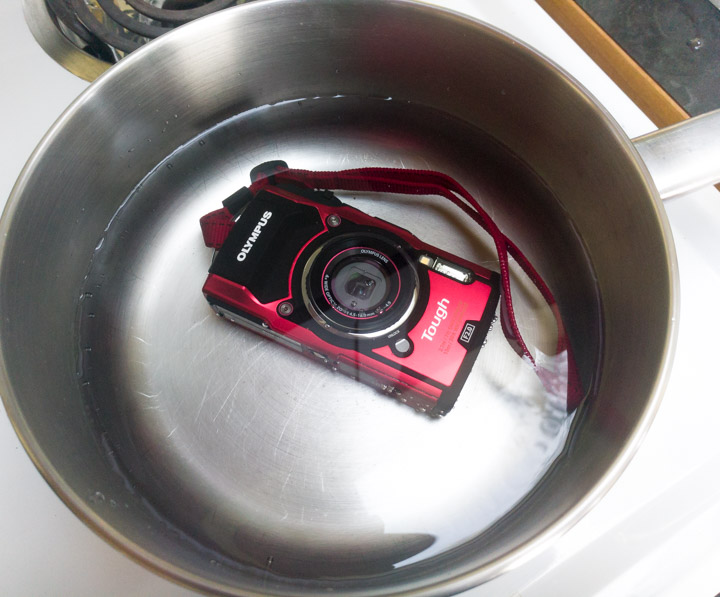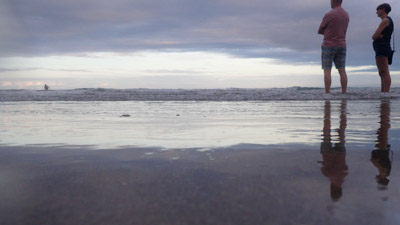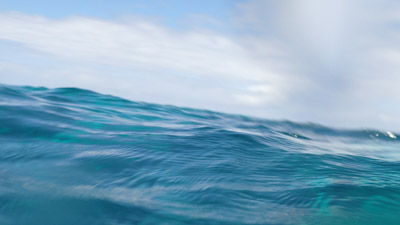
Olympus TG-5 “Tough” Waterproof

I found myself vacation-bound to Queensland (that’s the top right corner of Australia) and the itinerary included beaches and coral, specifically the Great Barrier Reef, which is dying. I like to photograph the places I visit, and the Olympus TG-5 is getting lots of buzz in waterproof-cam circles, so I got one.
The manual says that when it’s been in the ocean,
you should give it a ten-minute freshwater soak.
Camera geekery · The Oly TG “tough” cameras have been underwater stalwarts for years, and the -5 differs from its predecessors notably in shooting RAW, offering 4K video, and having fewer megapixels, for better low-light sensitivity. Oly obviously knows what camera geeks want to hear.
Up until the point that phones became good cameras, I’d always had a “pocket cam”. On this trip I had one again, and it was kind of nice. It doesn’t actually take better pix than my Pixel, but unlike any phone-cam it has a competent little zoom (30-100mm equivalent). What’s weird though (if you haven’t dealt with a marine model before) is that the zoom is all internal, there’s a soft hum but no moving parts. That’s probably why the sensor’s so small. Anyhow, it’s small enough to take along on the airplane and shoot out the window.
The first is near Vancouver; the sandbar is somewhere
in the blue water between Auckland and Cairns.
Couldn’t have captured either with a phone.
It’s pretty easy and fun to use; too many “modes” for a Fujiholic like me, but I mostly left it on auto and thought it mostly did the right thing.
As with all modern cameras, the image quality is not terrible, probably better than almost anything digital much before 2010.
Could you take that with a phone? Sure, since it’s zoomed right out; but only if you didn’t mind taking your phone into chest-deep seawater.
It’s also got an interesting “microscope mode” for extreme close-ups. I had a lot of trouble getting anything useful out of that. These leaves are absurdly tiny. My problem was finding things that were tiny and also interesting.
Under water! · Well, that’s what I got it for. These are all taken at Agincourt Reef. Pictures first, then a few notes.
I was just snorkeling and free-diving (on top of which I had a cold, which gets in the way) — this would be a lot easier with scuba gear and a clear head. The pix out of the camera were pretty uninspiring, but since it shoots RAW, I could bring Lightroom muscle to bear. In particular, its Dehaze control (under the Effects menu) was very helpful. Two things come to mind: First, underwater photography is hard, and I’d never done it before. And compared to Hawai’i, the Great Barrier Reef has much less underwater color and visual drama; the above are definitely highlight-reel shots.
The camera comes with three different underwater presets, but after about the first ten minutes, I gave up and put it in the “P” mostly-auto mode and went with that.
It was great fun and I’m looking forward to another outing; I know I can do better and I’m determined to try.
Video! · The two little pix to the right are linked to short movies, shot at 4K and reduced to 1280x720, so “only” 41 and 23 MB respectively. I trimmed and exported them in Lightroom, but that’s all the video editing it offers; they’re otherwise straight outta the camera. I have no idea how this will work on your browser, I’m a complete video virgin.

For the first, I set the camera down in the sand just where the waves were petering out, let it run for a bit, then zoomed out. Pre-zoom, you can see one wavelet bounce back off the camera. After, watch how the auto-focus works with the waves, which is not bad. I think I’m going to take one of these at every future beach I visit.

The second is what I guess people buy these things for, just a record of part of a short free dive, max depth maybe three meters. It shows the coral colors as they mostly are, and without direct sun; not terribly intense or exciting. But there are a couple of yellow fish and the ascent is visually satisfying.
There’s so much craft in producing decent video and I don’t have any of it. But if you do, or if you just like taking pictures underwater, or having a camera you can set down on the beach or use in places where no sane person would take one, the TG-5 is a pretty good choice, I think.
It’s dying · The Great Barrier Reef I mean, killed by this insane uncontrolled experiment where we dump megatons of carbon into our planet’s air without considering the consequences. That’s one reason we went. It’s also a reason I don’t want Canada exporting any more of the carbon-laden crap coming out of the tar sands, and will do what I can to keep that from happening.
And, I have to admit, we should all be doing less flying around in airplanes. If the only flights were for vacations, and to worship at natural temples like this one, we could probably still save the earth, or at least the coral.
Comment feed for ongoing:
From: Daniel (Aug 14 2017, at 03:04)
> I have to admit, we should all be doing less flying around in airplanes
This rule should especially apply to climate activists with loud speakers and Nobel Prizes. e.g., Al Gore. One grows weary of virtue signaling and hypocrisy.
[link]
From: Ed Davies (Aug 14 2017, at 06:42)
Anti-spam: “Are there more or less than five states in the United States?”
Luckily I didn't have to be rejected by answering “fewer”.
If all 11 billion people expected to be around later this century took a return trip Vancouver-Sydney every year with current fossil-fuel-powered aircraft that'd amount to somewhat more than half of current emissions. To save the coral we need to reduce to a lot less than that.
[link]
From: Paul Cotton (Aug 14 2017, at 16:29)
Cathy uses a Sealife camera for her underwater photography. Check out her photos from our trip to Baros, Maldives in April 2017.
https://www.flickr.com/photos/cathycotton/albums/72157679313031114
/paulc
[link]
From: Nathan (Aug 14 2017, at 20:33)
I'm an AWS employee in the Sydney office who follows this blog - would love to meet if you are ever in the area!
[link]
From: Kris Obertas (Aug 15 2017, at 07:56)
Tim, I've been pondering this type of camera, thanks for the info and samples.
My use case is paddleboarding, mostly in English Bay. I took a non-waterproof cell phone out, and even with double dry bag protection, I'm guessing condensation made it glitchy until it dried out.
Then I bought a knock-off GoPro type cam, but the lens is so wide angle and makes any scenery in a photo or video at more than close proximity seem tiny and far away.
Didn't buy a new cam this season but next year for sure! I was basing my options on Wirecutter reviews which seem to be a generation behind.
Kris O.
[link]
From: Ted (Aug 16 2017, at 23:26)
Hi Tim, Maybe your next vacation should be a tree-planting week. I'd suggest Trees For Life but I'm not sure the two hundred or so saplings you'd plant would fully atone for all the carbon released getting to Scotland and back. There must be forest restoration schemes nearer home though, in BC or the Pacific North West. Anyway I recommend it. Wherever it is, there'll be great people and great craic.
Best wishes
Ted
[link]
From: g (Aug 18 2017, at 04:42)
Daniel,
Seems to me it should apply *less* to people in that position.
Let's suppose (as I in fact believe, but treat this as hypothetical if your own opinions diverge) that man-made climate change is a real thing, that it's made worse by air travel, and that it is liable to do a lot of harm.
Case 1: I am taking a holiday and can either fly or not fly. Not flying means less time at the destination, or going somewhere less interesting. Environmental effect: clearly better if I don't fly.
Case 2: Al Gore has an invitation to go somewhere and try to persuade people to do something about climate change. He can do it if he flies; he can't, or won't have time for some other piece of activism, if he doesn't fly. Environmental effect: arguably better if he *does* fly, depending on how influential his activism actually is.
Now, again, this depends on how much effect his speeches and whatnot have, in encouraging anti-CO2 legislation or motivating individuals to reduce the impact of their activities, or whatever. If it turns out that he's achieving nothing to speak of then sure, his air travel's environmental harm isn't balanced out by anything good. But if a typical trip has effect equivalent to persuading one person to cancel one comparable trip of their own, he breaks even.
None of this applies if Gore's just going on holiday, of course. And I think he has a private jet, which is surely much worse environmentally than taking an ordinary commercial flight that's shared with many other passengers. But it still looks to me as if (making only modestly optimistic assumptions about how effective his work is) Gore's coming out comfortably positive-for-the-environment, no matter how much of a hypocrite you may think he is.
[link]
From: S. Rose (Aug 18 2017, at 06:25)
My partner ruined one of these cameras the first time they took it underwater by not having set the latches properly. Make sure you understand and set the locked positions before you descend.
[link]
From: Chris (Aug 24 2017, at 18:57)
Tricky to arrange with a pocket camera, but my understanding is that to get real colour you'll need to bring lights down with you - the red filtering happens so fast that even shallow dives are mostly blue-green.
[link]
From: A Kass (Sep 04 2017, at 04:05)
I love this camera format: very pocketable, waterproof and shockproof, and still better quality than smart phones. They're great for hiking and backpacking, in addition to beaches and bad weather. Personally, I have the Panasonic Lumix DSC-TS5, which seems mostly equivalent (but no raw), though I like the image quality better (as compared on dpreview a while ago--so could be moot). Also, the Olympus had faster time-to-shoot specs, mine can snap a picture within a second or two of pulling from my pocket.
For underwater use, the Panasonics have underwater mode that removes the red cast. Colors are never perfect and still require 'shopping, but it speeds up the process. I can confirm what the other poster wrote: you have to open the camera in a clean environment and meticulously brush the gasket befor closing.
I have a TS3 that still works and bought the TS5 twice after killing one with sand in the seal. I almost bought the Olympus last time, the add-on lenses were tempting, but then I realized they negated my use case (pocketable and fast to shoot). Sadly, the Panasonic seems discontinued, and the Olympus is $100 more expensive (more with the add-on lenses).
Anybody remember the Olympus Stylus Epic (film camera)? It was my backpacking camera back in the day, but it died when I tried to take it swimming and water got into the double ziploc.
[link]